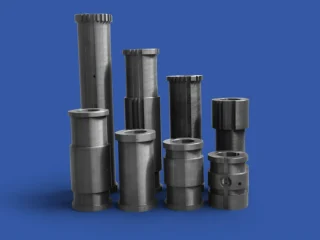CLEMSON — Minerals that endure in nature for millions of years are inspiring a Clemson University-led research team to explore whether new materials could be developed to encase nuclear waste for safe storage.

Kyle Brinkman works in the Olin Hall lab where he and his team are developing new materials that could help broaden nuclear-waste disposal options and lower storage and disposal costs.
Glass is now used to isolate nuclear waste, but a team led by Clemson’s Kyle Brinkman is hoping to develop materials that are more stable. The team’s work could help broaden disposal options and lower storage and disposal costs.
The three-year project recently won an $800,000 research grant from the U.S. Department of Energy’s Nuclear Energy University Programs.
The team’s research is focused on crystalline ceramic that will be based on naturally occurring minerals that endure for millions of years. One example is hollandite that is dug out of the Italian Alps and shows promise for housing cesium.
“Our project is to learn from these naturally occurring, naturally stable minerals and design crystal structures that mimic them to incorporate waste elements we want to store,” said Brinkman, a Clemson associate professor of materials science and engineering.
Anand Gramopadhye, dean of the College of Engineering and Science, said the research is a good fit for South Carolina, where about half the energy is generated by nuclear power.
“It is vital to our health and our environment to find safe storage options for nuclear waste,” Gramopadhye said. “We owe it to South Carolina and our nation, not only for us, but also for our children and future generations.”
The research is aimed at giving policymakers the data they need to weigh options as they decide whether to recycle used nuclear fuel from commercial power plants. That waste is now kept at nuclear power plants in pools or dry-cask storage across the country.
Current U.S. policy is to not recycle used nuclear fuel.

Ashley Hearing, a graduate student from Marlton, New Jersey, works in the Olin Hall lab as part of research into whether nature could inspire new materials for storing nuclear waste.
Components of used nuclear fuel can be reprocessed into fresh fuel. But even with reprocessing, some leftover material is no longer usable.
The crystalline ceramic that researchers are developing would encase the leftover material. Once it’s trapped in the crystalline ceramic, it would be put in a container and buried in a miles-deep repository in a stable rock formation. The crystalline ceramic would act as a last line of defense, keeping the waste from spreading if it should ever come in contact with water.
Researchers believe the crystalline ceramic would be more stable than glass, which is now used by several countries to isolate high-level commercial and defense waste. The waste is melted into the glass, a process called vitrification, and then put it in a repository.
“Glass is a proven material for incorporating high-level waste,” Brinkman said. “However, over millions of years, it is believed that ceramics would be even better. So our project is to look at crystalline materials.”
Collaborators on the project are Rajendra K. Bordia, chairman of Clemson’s materials science and engineering department; Kenneth L. Reifsnider of the University of South Carolina; Wilson K.S. Chiu of the University of Connecticut; and James C. Marra of Savannah River National Laboratory.
“The research will help us strengthen ties between Clemson University and Savannah River National Laboratory,” Bordia said. “It also helps South Carolina boost its already strong national reputation in nuclear research. We’ve built a specialty in finding the safest ways to generate nuclear energy and dispose of the waste.”
Several separate nuclear-related projects are underway in Clemson’s College of Engineering and Science, including one that was recently awarded $5.25 million to conduct field experiments on waste.
Clemson researchers will make and analyze the crystalline materials but will not need to use nuclear waste for the research. They will send the ceramics to collaborators for further analysis and to make three-dimensional computer simulations.




 Enquiry
Enquiry